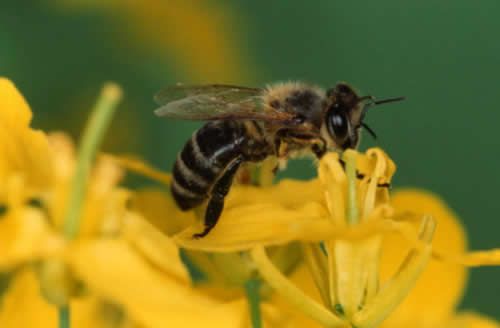
The European Court of Justice (ECJ) ruled last week that pollen from genetically modified (GM) plants contained in honey counts as a food ingredient and requires authorisation. Initial reactions from politicians and associations welcome the ruling unanimously because it creates legal certainty at last. Opinions vary, however, regarding the possible consequences. Whereas Bavaria’s Environment Minister, Markus Söder (CSU), a number of environmental associations and the German Beekeeping Association (D.I.B.) are calling for safety distances of between three and ten kilometres between beehives and fields with GM crops, some beekeepers and the German honey association (Honig-Verband) are worried that the ruling could spell the end for some beekeepers.
Until then, pollen in honey had been a special case that was not clearly regulated by food legislation. It was seen as a natural component of honey that is added unintentionally during honey production in the beehive. Pollen from GM plants was therefore classified as an adventitious, technically unavoidable impurity. This situation has now changed. Although pollen in honey does not constitute a genetically modified organism (GMO), according to the ECJ ruling, because it has lost its ability to reproduce, it is an ingredient "produced from GMOs". It is immaterial whether the pollen was added to the honey intentionally or adventitiously.
One of the consequences of reclassifying pollen as a food is that honey containing pollen from GM plants now falls within the scope of the regulation on genetically modified food and feed. This means that honey containing GM pollen can be placed on the market only if the GMO in question has been authorised as a food. All unauthorised GMOs are subject to the zero tolerance policy. It is not yet clear what this will mean for the considerable quantities of imported honey, especially those from Argentina and other South American countries. Assessments here range from "no consequences" to "a de facto import ban". The German honey association assumes that "for the vast majority of honeys, the pollen comes from GM plants that have been authorised as food in the EU".
No impacts are expected for honey produced in Germany, since no GM plants are grown there commercially. The situation is different for honey from other European countries, especially Spain, where MON810 Bt maize, which has been authorised for cultivation in the EU, is grown on around 80,000 hectares. Certain products like cornflour and maize starch from MON810 maize were authorised as foods under the old genetic engineering legislation, but there has been no explicit authorisation for the maize pollen. This means that the zero tolerance policy currently applies to MON810 maize pollen until the ongoing reauthorisation process is complete.
It remains to be seen what this will mean for beekeepers and what practical detection methods can be used. Honey that contains pollen from authorised GM plants has to be labelled as such only if the GM pollen accounts for more than 0.9 per cent of the total pollen content (the labelling threshold). This is not likely to apply in most cases.
Leaving aside the GMO problem, the fact that pollen is now classified as a food is likely to have far-reaching consequences for beekeepers and the food industry. In future, pollen must be included in the list of ingredients, which means that every batch of honey will have to be analysed for the presence of pollen. It is possible that labels will have to include allergy advice about certain types of pollen, e.g. hazelnut pollen. In any event, beekeepers are going to find themselves facing as yet unforeseeable financial burdens and liability consequences.
Three, five or ten kilometres
No sooner was the ECJ’s judgement published than the German Agriculture Minister, Ilse Aigner, announced that the current separation distances would have to be reassessed. Bavarian Environment Minister Markus Söder went into more detail and called for a 3 km safety distance between beehives and fields with GM crops. Friends of the Earth Germany (BUND) and the German Society for Nature Conservation (NABU) are calling for a separation distance of at least five kilometres, and the President of the German beekeeping association (DIB), Peter Maske, is calling for ten kilometres. "That should make this type of crop farming unattractive and impractical for farmers," says Maske.
Until now, under the rules of good farming practice for maize, the separation distances have been 150 m between GM maize and conventional maize fields, and 300 m between GM and organic fields. The amendment of Germany’s genetic engineering law, which has been announced for this autumn, can now be expected to contain a reassessment of these separation rules. In addition, there are plans to let Germany’s regions set their own separation rules. "We want to decide for ourselves what is planted on Bavarian soil and in Bavarian fields," Söder emphasizes, pointing out that Bavaria has not grown any GM crops since 2010.
Only Saxony’s Ministry of the Environment and Agriculture is taking a different stance. Despite the honey ruling, Saxony does not intend to join the ranks of GM-free regions, claiming that the benefits and risks of genetic engineering should be weighed up on a case-by-case basis, and that farmers should continue to have freedom of choice.
The ECJ ruling is likely to have less of an impact on commercial crop farming, since no GM crops have been grown since MON810 maize was banned in 2009. However, things would now become ’uncomfortable’ for field trials, according to NABU, because they will have to be kept well away from beehives. It is indeed likely that it will become more difficult to conduct field trials at all in future if the scientists involved risk being made accountable for the theoretical possibility of GM pollen grains ending up in honey.
